Any links to online stores should be assumed to be affiliates. The company or PR agency provides all or most review samples. They have no control over my content, and I provide my honest opinion.
The ECW516L is the latest cloud-managed access point from EnGenius. It is a tri-band Wi-Fi 7 access point designed for small to medium-sized businesses. It operates across the 2.4 GHz, 5 GHz, and 6 GHz frequency bands, offering combined wireless speeds of up to 13.7 Gbps.
What is different about this from my other EnGenius reviews is that it is part of the new. Cloud AP Lite Series range of access points, which effectively reduces the features in comparison to the normal cloud models at a lower price point, making it appealing for small businesses and prosumers.
The EnGenius ECW516L has an RRP of $199, making it competitive against the popular Unifi U7 Pro and the excellent Zyxel Nebula NWA130BE.
Related Reviews
- EnGenius Switch Extender EXT1106 Review
- EnGenius ECW526 WiFI 7 Access Point Review vs EnGenius ECW536 & Unifi 7 Pro
- EnGenius ECW536 WiFi 7 Access Point Review – The most affordable 10GbE 4×4 MIMO WiFi 7 AP
- EnGenius ECP106 Cloud Managed Switchable Smart PDU Review
- EnGenius EXT1105P Switch Extender Review
- EnGenius Fit6 4×4 EWS377-FIT Access Point & EWS2910P-FIT POE Switch Review
- EnGenius FIT Review
Specification
| Specification | EnGenius ECW516L |
| Wireless Standards | IEEE 802.11be on 2.4 GHz, 5 GHz, and 6 GHz |
| Backward Compatibility | 802.11a/b/g/n/ac/ax |
| Antenna | 2×2 2.4GHz (5 dBi), 3×3 5GHz (5 dBi), 3×3 6GHz (5 dBi) Integrated Omni-Directional |
| Physical Interfaces | 1 x 2.5GE PoE+ Port, 1 x DC Jack, 1 x Reset Button |
| LED Indicators | Power, LAN, 2.4 GHz, 5 GHz, 6 GHz |
| Power Source | Power-over-Ethernet 802.3at Input, 12VDC /2A Power Adapter |
| Maximum Power Consumption | 20.7W |
| Operating Frequency | Tri-Radio Concurrent 2.4 GHz, 5 GHz, and 6GHz |
| Operation Modes | AP, AP Mesh, Mesh |
| Frequency Bands | 2.4 GHz: 2400-2482 MHz; 5 GHz: 5150-5850 MHz; 6 GHz: 5925-7125 MHz |
| Transmit Power | Up to 22 dBm on 2.4 GHz, 5 GHz, and 6 GHz |
| Radio Chains | 2×2:2, 3×3:3 |
| SU-MIMO Data Rates | 700 Mbps (2.4GHz), 4,300 Mbps (5GHz), 8,700 Mbps (6GHz) |
| MU-MIMO Data Rates | 700 Mbps (2.4GHz), 4,300 Mbps (5GHz), 8,700 Mbps (6GHz) |
| Supported Data Rates | 802.11be: Up to 8,700 Mbps; 802.11ax: Up to 3,600 Mbps; 802.11ac: Up to 1,733 Mbps; 802.11n: Up to 600 Mbps |
| Supported Radio Technologies | OFDMA (802.11be/ax), OFDM (802.11a/g/n/ac), DSSS (802.11b) |
| Channelization | EHT 20/40/80/160/320 MHz, HE 20/40/80/160 MHz, VHT 20/40/80 MHz, HT 20/40 MHz |
| Supported Modulation | BPSK, QPSK, 16-QAM, 64-QAM, 256-QAM, 1024-QAM, 4096-QAM |
| Max Concurrent Users | 128 per radio |
| Client Balancing | Yes |
| Auto Channel Selection | Yes |
| Regulatory Compliance | FCC, CE, IC, UKCA, UK PSTI, AU |
| Operating Temperature | 0°C to 40°C (32°F to 104°F) |
| Storage Temperature | -40°C to 80°C (-40°F to 176°F) |
| Operating Humidity | 90% or less (non-condensing) |
| Storage Humidity | 90% or less (non-condensing) |
| Weight | TBD |
| Dimensions | 205 x 205 x 33 mm |
| VLAN Support | 802.1q SSID-to-VLAN Tagging, Cross-Band VLAN Pass-Through, Management VLAN |
| QoS Support | IEEE 802.11e, WMM |
| SNMP Support | v1, v2c, v3 |
| Fast Roaming | 802.11r/k |
| Wireless Security | WPA2-PSK, WPA3-PSK, Hidden SSID, Client Isolation, Access Control |
| Network Interface Support | IPv4, IPv6 |
| Local Web Access | HTTP, HTTPS |
| Multiple BSSID | 8 SSIDs per 2.4GHz and 5GHz bands |
Features
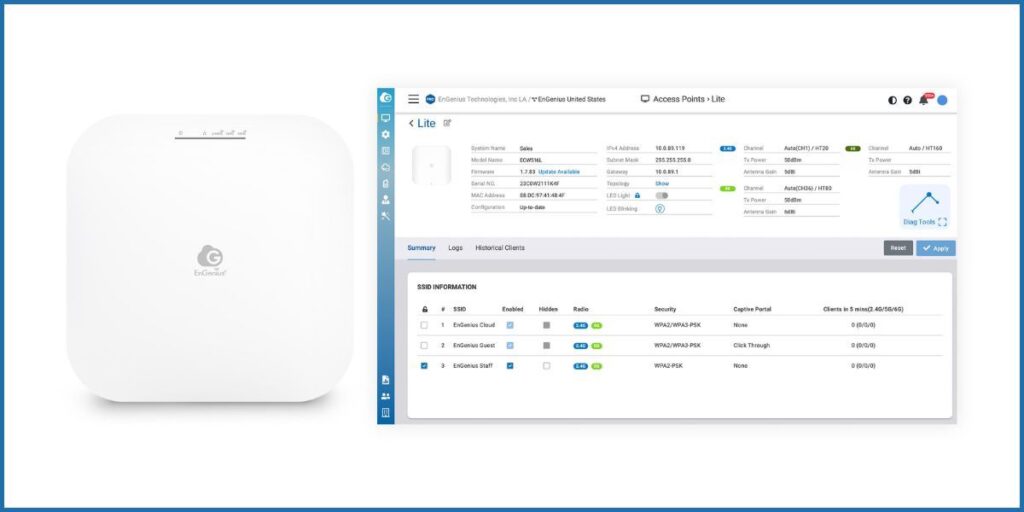
- Wi-Fi 7 Technology: Supports 320 MHz channel bandwidth, Multi-User Multiple Input Multiple Output (MU-MIMO), 4096-QAM, Multi-Link Operation (MLO), and Multi-RU puncturing. These features contribute to improved data transmission efficiency, reduced latency, and enhanced overall network stability.
- Coverage and Capacity: Provides up to 1,200 square feet of wireless coverage and supports up to 200 simultaneous client connections, making it suitable for small to medium business environments.
- Tri-Band Connectivity: Operates on three frequency bands:
- 2.4 GHz: Suitable for legacy devices and long-range connectivity.
- 5 GHz: Offers faster speeds with reduced interference.
- 6 GHz: Provides additional capacity for modern high-speed applications.
- Single 2.5 GbE PoE+ Port: Ensures high-speed wired connectivity and supports Power over Ethernet (PoE+) for flexible deployment without requiring additional power cables.
EnGenius Cloud vs EnGenius Cloud Lite
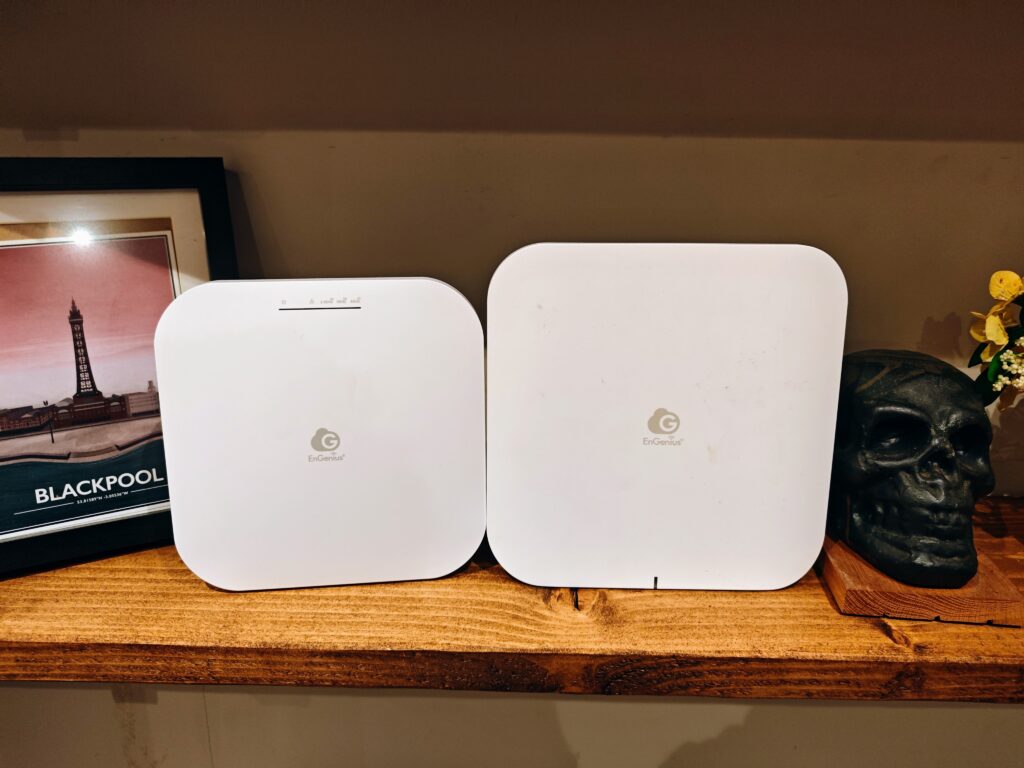
It is great that EnGenius have multiple options to cater for different budgets but it is starting to become increasingly complex to understand the different options.
You now have:
- EnGenius ECW Cloud
- EnGenius ECW Cloud Lite – managed with the same UI as EnGenius Cloud but with slimmed-down features.
- EnGenius FIT – This has two management options, either a FitController100 which replicated the same UI as EnGenius Cloud or EnGenius FitXpress which is a much more basic cloud management option.
Basically, the aim of the Cloud AP Lite Series is to target smaller businesses where you don’t want ongoing licensing fees to access all the features.
| Feature | Cloud AP Lite Series | Normal EnGenius Cloud APs |
| Target Audience | Small businesses (1-50 users) | Small to mid-sized businesses (100-500+ users) |
| Licensing | No license required (optional Pro upgrade) | Pro or Basic license required |
| Features | Basic Wi-Fi features only (VLANs, guest networks, captive portal) | Advanced features (Google Authentication, MyPSK, LDAP, Azure AD, Radius) |
| Max Concurrent Clients per AP | ~100 devices | Up to 1000 devices |
| Security Features | WPA3, guest isolation, VLAN segmentation | Advanced authentication, Wi-Fi security suites, MyPSK, Google LDAP, dynamic VLANs |
| Supported Devices | Only Lite Series APs, but works under EnGenius Cloud ecosystem | All Cloud-managed EnGenius APs, switches, gateways, PDUs, cameras (future) |
| Cloud Features | Centralised management, but limited API integrations | Full API support, advanced monitoring, traffic analysis, and automation |
| Upgradeability | Can upgrade to Pro plan for additional cloud features | Already includes advanced networking features |
| Price Range | $99 – $199 (one-time cost) | Higher cost due to pro features & licensing |
To add to the confusion, the new ECW Lite range has a professional plan option which adds features, but not the same features as the full EnGenius cloud models.
| Access Point | ECW Lite – Basic Plan | ECW Lite – Professional Plan |
| Statistic Data Storage | 1 Day | 30 Days |
| Cloud Radius and Voucher Service | 100 | 100 |
| Change Log | Yes | Yes |
| Alert Notification | On-line/Off-line | On-line/Off-line |
| Backup & Restore | – | Yes |
| Clone Network | – | Yes |
| Client List Export | – | Yes |
| Topology | Yes | Yes |
| API Integration (3rd party) | – | Yes |
| Broadcast Suppression | Yes | Yes |
| Application QoS(AVXpress) | Yes | Yes |
| Live Diag Tools | Limited | Limited |
| Live Client List | – | Yes |
| VIP/Allowlist/Block List | 100 | 100 |
While the EnGenius product lineup is getting a bit confusing, what I like about these new Lite models is that they can be integrated within the normal EnGenius cloud and will work with the other normal EnGenius products, just with fewer features.
So, as a business grows, you may start with the ECW Lite models to keep costs down but eventually introduce the standard ECW cloud devices. In this scenario, you don’t have to replace all the hardware; you can slowly migrate things based on client needs and budgets.
Then, the ECW Lite Pro plan is useful for unifying your Lite devices with ECW Pro devices.
EnGenius has a page covering the features of ECW and ECW Lite, plus a comparison of the basic and professional plans.
Set-Up
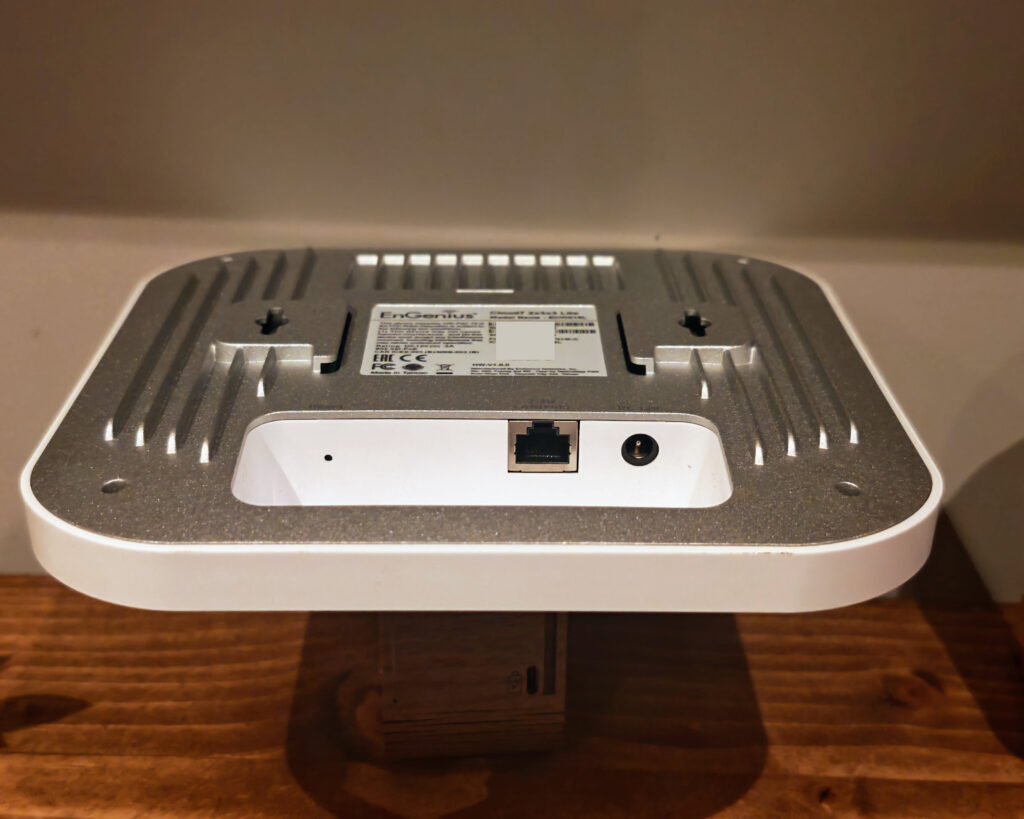

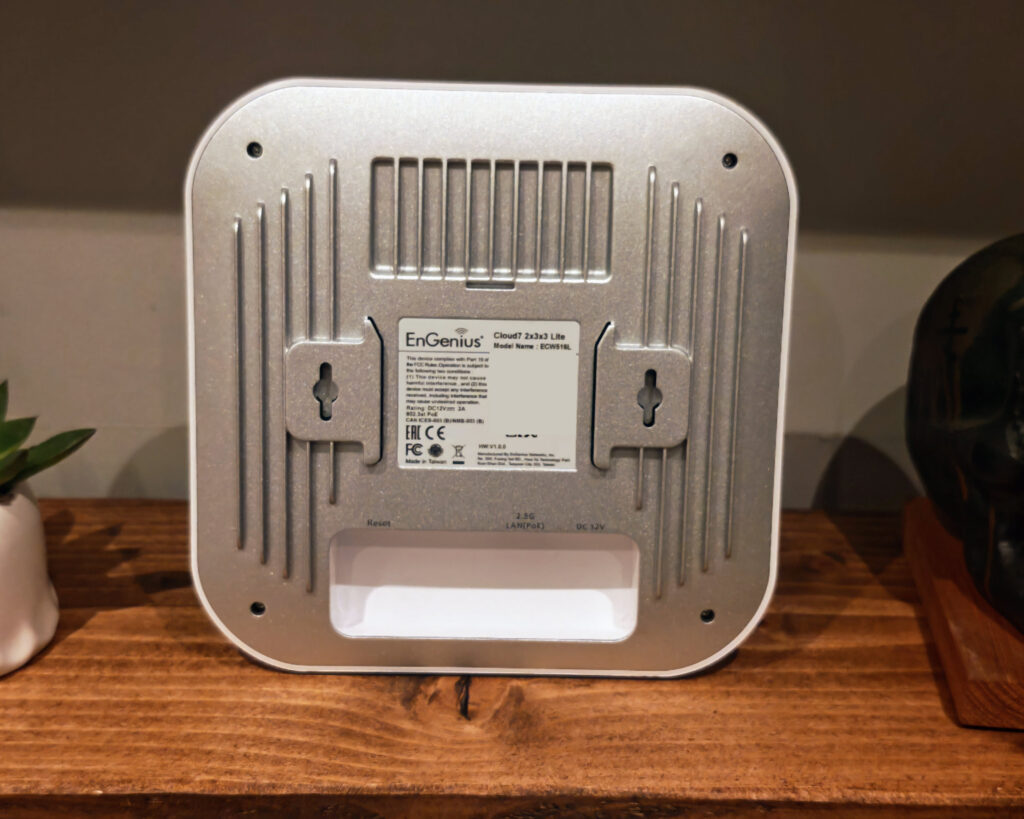
As this access point uses the normal EnGenius Cloud interface, the overall experience is identical to the other EnGenius access points.
Therefore, I set this up just the same as my other reviews. I powered on the AP, then added it into my system with the EnGenius Cloud to Go app by scanning the QR code on the AP.
EnGenius Cloud User Interface and Settings
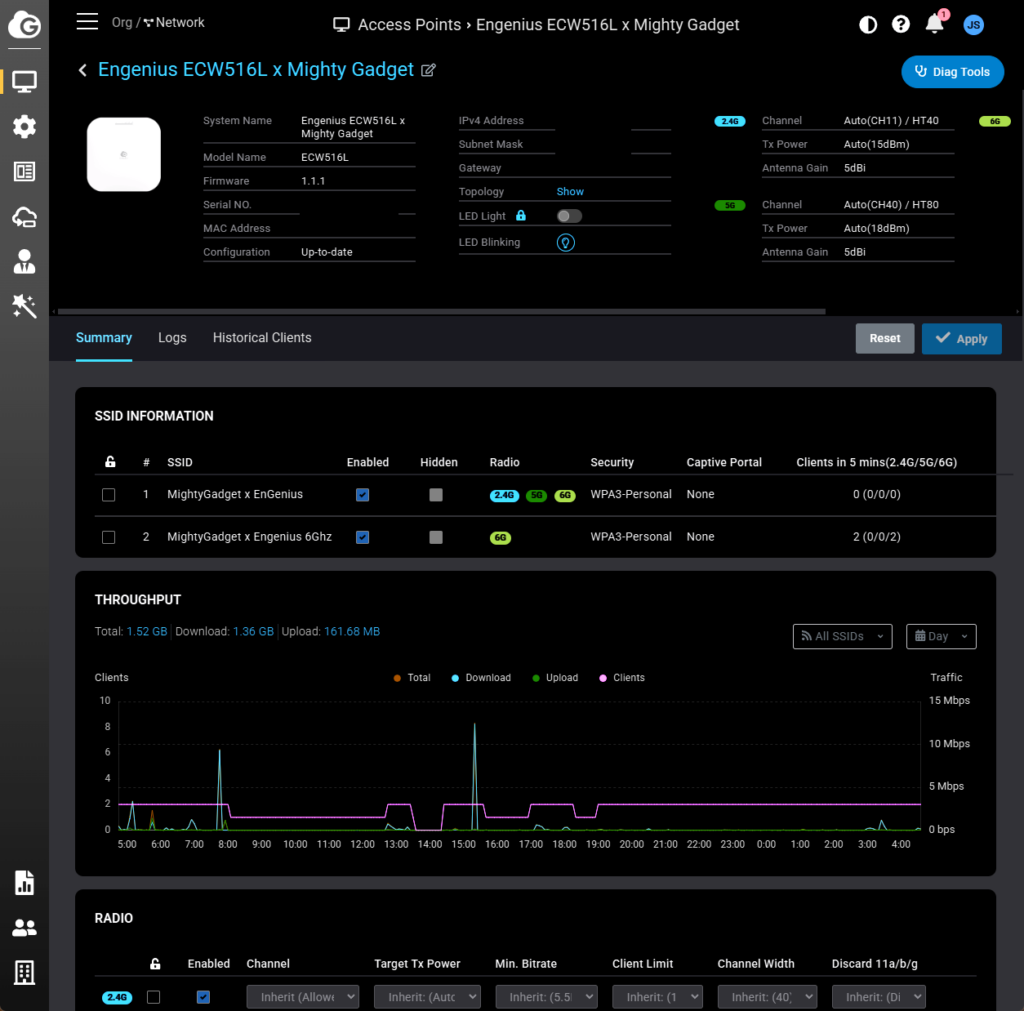
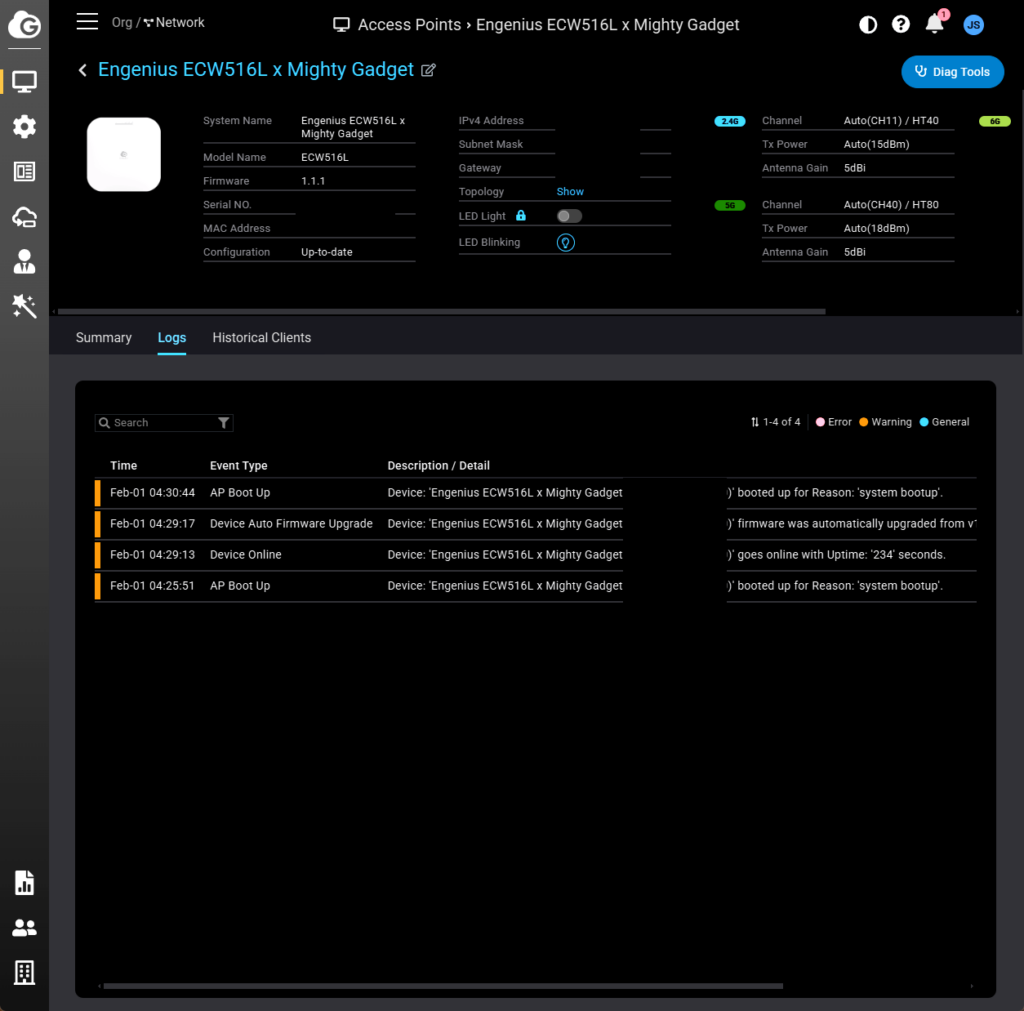
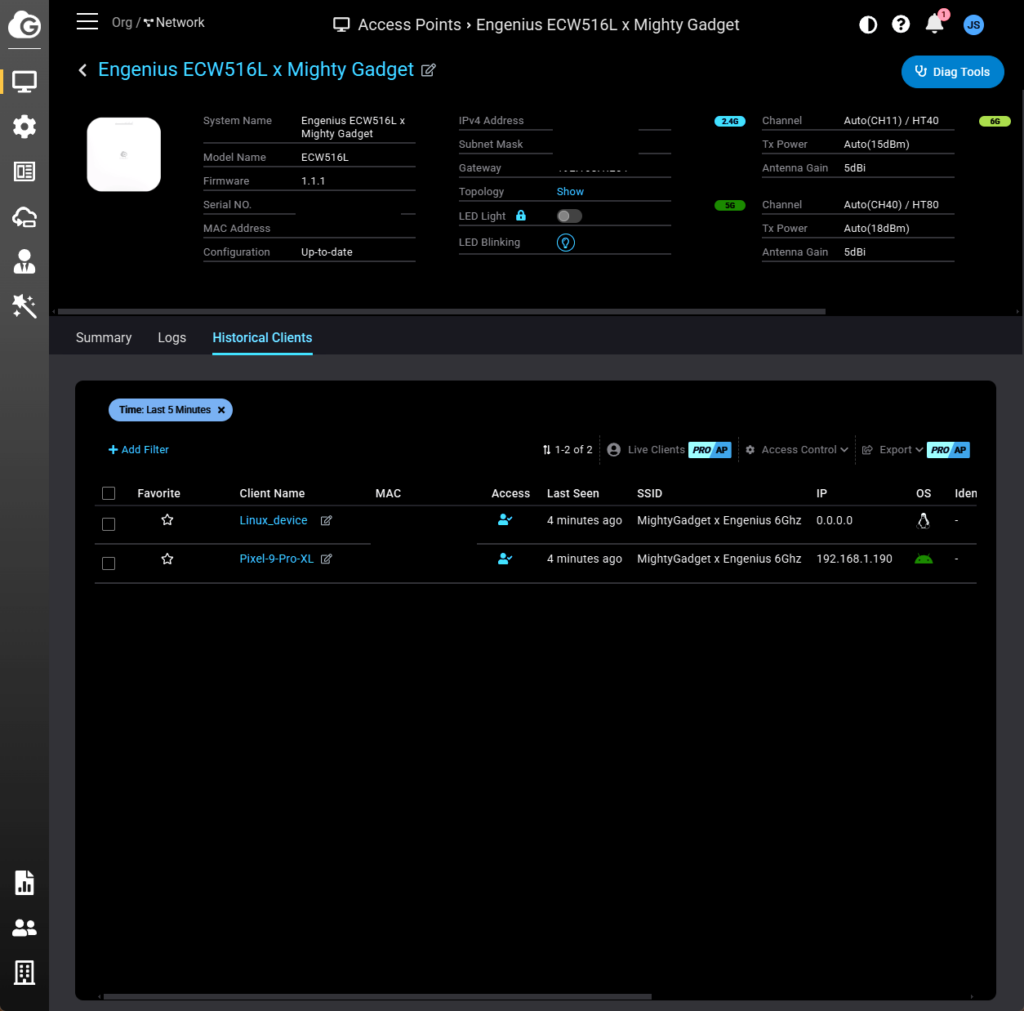
For the majority of the settings and user experience, the ECW516L appears to function just like the normal access points. The UI is identical to my previous reviews. For smaller businesses or enthusiast home users like myself, the overall experience is almost identical.
In my case, I don’t have a Pro licence on the standard ECW access points I have such as the ECW526, therefore things like Active Directory and Azure AD authentication are not available anyway.
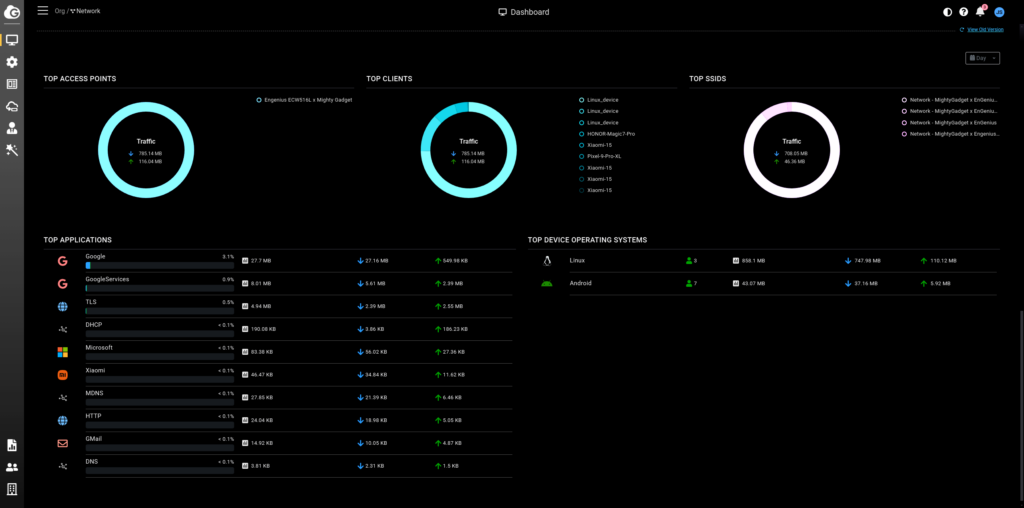
Small businesses would likely want a captive portal, but the ECW516L still supports that. You are just limited to clicking through, EnGenius Authentication, Custom RADIUS, and Voucher Service. The vast majority of captive portals I have accessed use basic authentication like click through or vouchers.
The lack of SmartCasting on the Lite models will limit the appeal for some hotels, but the hotels that tend to use WiFi casting for TVs tend to be larger and, therefore, are unlikely to opt for the Lite models in the first place.
Channel Width Limitations
One caveat with this access point is that the 5GHz band is limited to 80Mhz channel width, whereas the flagship ECW536 can do 160Mhz, and the Unifi WiFi 7 access points can use up to 240Mhz.
This will be a significant negative for home users wanting to maximise their throughput, but it is not likely to be much of a problem in a commercial environment. Due to the limited number of none non-overlapping channels on 160Mhz, it is not practical for commercial use, and businesses are better off focussing on stability and reliability rather than maximising throughput.
Performance
For testing, I used the Ubiquiti Unifi Pro Max 16 PoE to power the access points.
I then compared the throughput with the flagship EnGenius ECW536, the Ubiquiti Unifi U7 Pro and the Zyxel Nebula NWA130BE, which are both similarly priced WiFi 7 access points.
For a server, I tested with the TerraMaster F4-422 10GbE 4-Bay NAS acting as a server for perf and OpenSpeedTest and the Geekom Mini IT13 Mini PC, which is limited to 2.5GbE and running Proxmox.
Devices I used to test throughput include:
- Pixel 9 Pro XL
- Honor Magic7 Pro
- Huawei Matebook 14 with Qualcomm NCM865 WiFI 7 Module
- Desktop PC with TP-Link Archer TBE550E Wi-Fi 7 Adapter, which is based on the MediaTek MT7927
It is worth noting that the ECW536 has a 10GbE port, and I was able to achieve a throughput of 3262 Mbps when I reviewed it. For the following tests, I ran the ECW536 on the same 2.5GbE port as the other access points.
Multi-Link Operation (MLO)

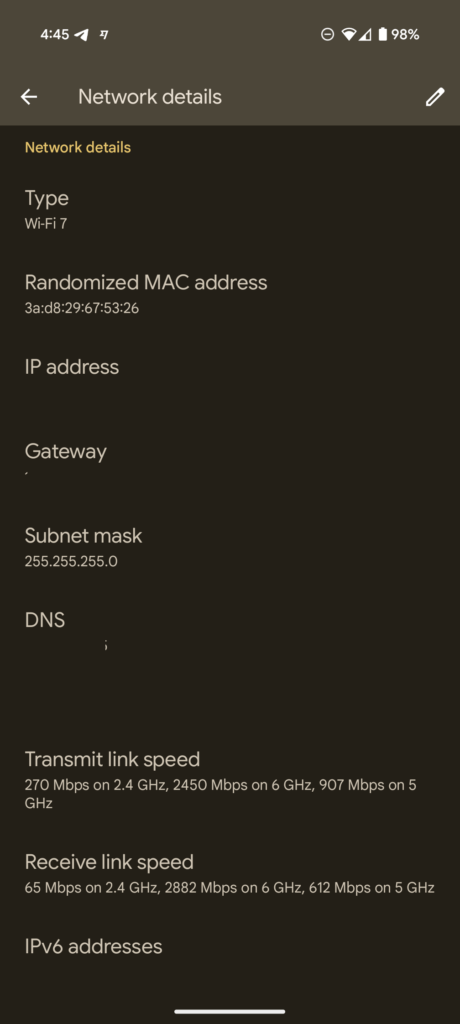
MLO is one of the main features of WiFi 7. It allows devices to connect to multiple bands at once if you use one SSID for 2.4GHz, 5GHz and 6GHz. It can significantly improve throughput while also improving reliability as the device does not switch between bands as you move around.
Annoyingly, MLO seems to have had a bit of a slow start, with very few devices supporting it. EnGenius, Ubiquiti and Zyxel now all support MLO, but the client device also needs to support it.
For Ubiquiti, you need to be running firmware version 7.1.18 or higher which is only available via early access.
With this review, it is the first time I have noticed a device definitely using MLO. The Pixel 9 Pro XL showed a connection with all three bands.
Unfortunately, MLO didn’t seem to provide any benefit. For a start, MLO seemed to work intermittently. I noticed the multi-band connection when testing the Pixel in the room below the access point, but when in my office, the Pixel seemed to just connect to 6GHz.
When connected to all three bands downstairs, I was only able to achieve a throughput of 364Mbps.
Close Range
- 6GHz
- EnGenius ECW516L: 2013 Mbps
- EnGenius ECW536: 2141 Mbps
- Ubiquiti Unifi U7 Pro: 2004 Mbps
- Zyxel Nebula NWA130BE: 2076 Mbps
- 5GHz
- EnGenius ECW516L: 925Mbps (limited to 80Mhz channel width)
- EnGenius ECW536: 1734 Mbps
- Ubiquiti Unifi U7 Pro: 1544 Mbps
- Zyxel Nebula NWA130BE: 1512 Mbps
- 2.4GHz
- EnGenius ECW516L: 321 Mbps
- EnGenius ECW536: 337 Mbps
- Ubiquiti Unifi U7 Pro: 342 Mbps
- Zyxel Nebula NWA130BE: 301 Mbps
Living Room – Down one floor
- 6GHz
- EnGenius ECW516L: 1081 Mbps
- EnGenius ECW536: 1174 Mbps
- Ubiquiti Unifi U7 Pro: 1068 Mbps
- Zyxel Nebula NWA130BE: 1213 Mbps
- 5GHz (80Mhz)
- EnGenius ECW516L: 663 Mbps
- EnGenius ECW536: 698 Mbps
- Ubiquiti Unifi U7 Pro: 687 Mbps
- Zyxel Nebula NWA130BE: 609 Mbps
- 2.4GHz
- EnGenius ECW516L: 122 Mbps
- EnGenius ECW536: 127 Mbps
- Ubiquiti Unifi U7 Pro: 140 Mbps
- Zyxel Nebula NWA130BE: 131 Mbps
Front Room – Down one floor and two rooms over
- 6GHz
- EnGenius ECW516L: 47 Mbps
- EnGenius ECW536: 46 Mbps
- Ubiquiti Unifi U7 Pro: 51 Mbps
- Zyxel Nebula NWA130BE: 32 Mbps
- 5GHz
- EnGenius ECW516L: 109Mbps
- EnGenius ECW536: 117 Mbps
- Ubiquiti Unifi U7 Pro: 147 Mbps
- Zyxel Nebula NWA130BE: 121 Mbps
- 2.4GHz
- EnGenius ECW516L: 86 Mbps
- EnGenius ECW536: 82 Mbps
- Ubiquiti Unifi U7 Pro: 86 Mbps
- Zyxel Nebula NWA130BE: 79 Mbps
Price and Alternative Options
The EnGenius ECW516L has an RRP of just $199. EnGenius has launched its own eCommerce store for Europe, but at the time of writing, the ECW516L is not available. Cable Management Warehouse lists it for £285.79 which will limit the appeal for UK buyers.
The next cheapest EnGenius WiFI 7 access point is the ECW526, which is available for $349. Then the flagship ECW536 is available for $589 including a 10GbE POE injector.
In the UK, the ECW526 is £437, and the ECW536 is £656, which, again, limits the appeal for UK buyers looking for the best value for money.
In comparison, Unifi has WiFi 7 access points priced at:
- E7 – $499 / £474
- U7 Pro Max – $279 / £264
- U7 Pro – $189 / £168
The ECW516L is somewhere in the middle of the U7 Pro / Pro Max. It has a 2×2(2.4GHz) and 3×3(5GHz/6GHz) antenna but a lower transmit power of 22 dBm.
The Zyxel Nebula NWA130BE is available for $160 / £170, and the NWA210BE is available for $170 / £212. It is annoying that UK buyers pay a premium, but in this case, that premium is not as significant as the EnGenius models.
Of course, Unifi has the advantage of no subscription fees at all. You need a controller.
Zyxel works similarly to EnGenius. Nebula’s core features are free, but advanced features are walled away in a subscription.
Overall
The ECW516L is an excellent addition to the EnGenius product lineup as it gives EnGenius a WiFi 7 access point that directly competes with the Unifi U7 Pro.
The low price point makes it appealing for small businesses, and with the growing number of access points at different price points, there is clearly a lot of appeal for MSPs that manage many clients, all with different budgets.
The $200 price point makes this appealing to home users, but the lack of 160 MHz channel width will put some buyers off. Unfortunately, for UK buyers, EnGenius products come with quite a big premium, which will limit the appeal for companies or home users considering affordable cloud-managed networking ecosystems.
Overall, if you are a US-based MSP looking for an affordable WiFi 7 access point, then I can give the EnGenius ECW516L a strong recommendation. It has all the features most small businesses need without licensing fees, and it can continue to be used if the business grows and requires more advanced features that are available in the standard ECW cloud-managed access points.
EnGenius ECW516L Cloud Managed 2x3x3 Lite Indoor Tri-Band WiFi 7 Access Point Review
Summary
The EnGenius ECW516L is a solid addition to the EnGenius product lineup, offering an affordable Wi-Fi 7 access point tailored for small businesses and prosumers. While it lacks some of the advanced features found in the standard EnGenius Cloud models, it provides a strong balance between performance and cost-effectiveness. The ability to integrate within the EnGenius Cloud ecosystem makes it an excellent choice for businesses looking for scalability without committing to expensive licensing fees. While home users may find the 80 MHz channel width limitation on 5 GHz a drawback, in commercial environments, stability and reliability take precedence over peak throughput. If you are an MSP or a small business seeking a budget-friendly Wi-Fi 7 solution, the ECW516L is well worth considering.
Overall
85%-
Overall - 85%85%
Pros
Affordable pricing, making it a good competitor vs the Unifi U7 Pro.
No licensing fees for core features, unlike some other cloud solutions.
Multi-Link Operation (MLO) and 4096-QAM for improved efficiency.
Seamless integration with the EnGenius Cloud ecosystem.
Suitable for SMBs and prosumers looking for a cost-effective access point.
Cons
- Limited UK availability and less favourable pricing for EnGenius products in the UK vs Unifi and Zyxel
Limited to 80 MHz channel width on the 5 GHz band, reducing maximum throughput.
Lacks some advanced features available in standard EnGenius Cloud APs, such as Google Authentication, MyPSK, and Azure AD.
MLO support is still inconsistent across client devices, limiting its real-world benefits.
The growing number of EnGenius product lines and cloud management options can be confusing.
I am James, a UK-based tech enthusiast and the Editor and Owner of Mighty Gadget, which I’ve proudly run since 2007. Passionate about all things technology, my expertise spans from computers and networking to mobile, wearables, and smart home devices.
As a fitness fanatic who loves running and cycling, I also have a keen interest in fitness-related technology, and I take every opportunity to cover this niche on my blog. My diverse interests allow me to bring a unique perspective to tech blogging, merging lifestyle, fitness, and the latest tech trends.
In my academic pursuits, I earned a BSc in Information Systems Design from UCLAN, before advancing my learning with a Master’s Degree in Computing. This advanced study also included Cisco CCNA accreditation, further demonstrating my commitment to understanding and staying ahead of the technology curve.
I’m proud to share that Vuelio has consistently ranked Mighty Gadget as one of the top technology blogs in the UK. With my dedication to technology and drive to share my insights, I aim to continue providing my readers with engaging and informative content.

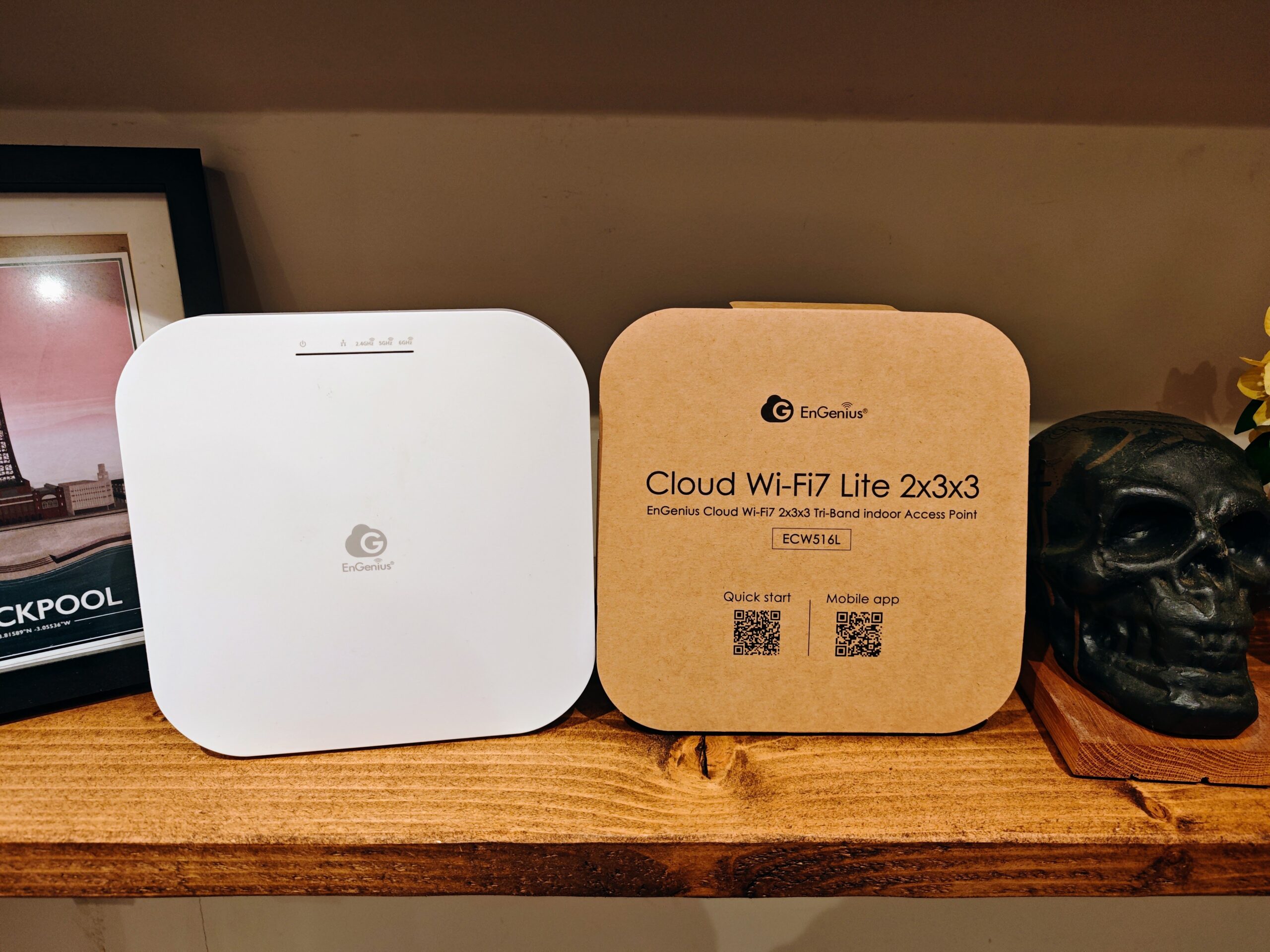

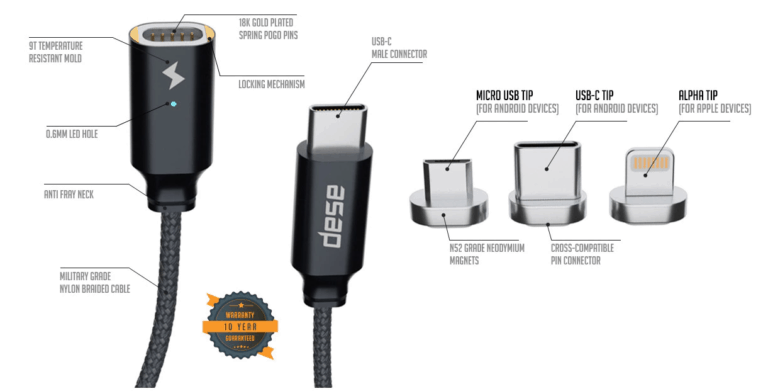
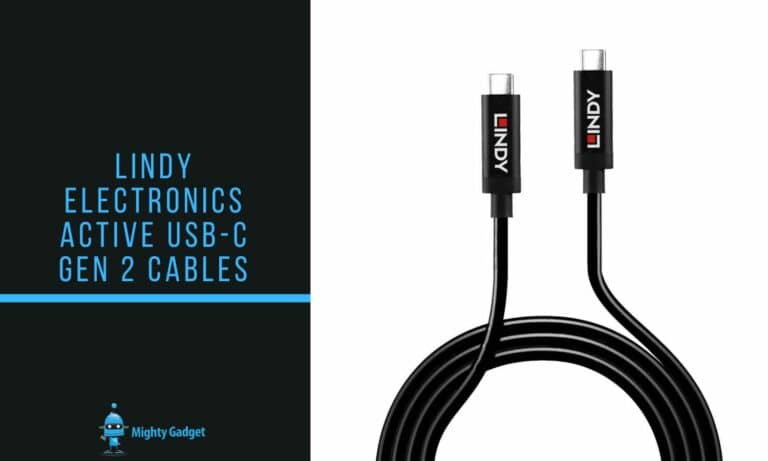



It is great that EnGenius have multiple options to cater for different budgets